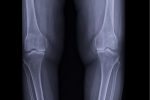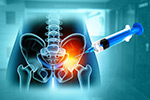Femoral anteversion is a congenital condition most common among children. According to John Hopkins Medicine, it occurs in 10% of children and is attributed to the abnormal positioning of the femur as a fetus grows in the womb. Femoral anteversion becomes more pronounced as children grow; they walk with an “in-toe” or their feet angled towards each other – and it usually resolves over time without the need for surgery.
That being said, femoral anteversion can still develop among adults. Femoral anteversion in adults can lead to mobility and balance problems and pain in the hip area. As such, it’s crucial to detect and diagnose the condition correctly so that patients can receive appropriate treatment and regain their ability to walk, run, and move effortlessly and painlessly.
What Is Femoral Anteversion?
The term “version” in anatomy refers to an organ’s rotation in relation to the rest of the body. With the prefix “ante,” femoral anteversion means the thigh bone (femur) and knee are excessively turned inward.
Femoral anteversion is also called hip anteversion. It is described as the forward rotation of the femur. It can happen to one or both legs. The rotation can also happen the opposite way, resulting in femoral retroversion.
How Can Femoral Anteversion in Adults Develop?
Adults who do not have femoral anteversion carried over from their childhood may develop this condition through the following situations:
-
Physical trauma from accidents or sports injuries (e.g., labral tears, femoral shaft fractures)
-
A bone fracture that healed incorrectly
-
A strong genetic inclination to develop rotational deformity
Femoral anteversion can also develop as a comorbid condition in adults diagnosed with:
-
Acetabular dysplasia
-
Hip impingement
-
Cerebral palsy
Femoral Anteversion in Adults Symptoms
When excessive femoral anteversion occurs, the articular cartilage (the smooth, elastic, connective tissue that covers the ends of the bones where they meet in the joints) and acetabular labrum (the soft cartilage that lines the rim of the hip joint where the “ball” or femoral head is situated) tears and gets damaged. The abductor lever arm (ALA) also reduces, and impingement (a condition in which tendons are caught or pinched between the hip rotator muscles and adjacent bones) often occurs.
As a result, people with femoral anteversion often experience the following:
-
Knee pain
-
Osteoarthritis of the hip
-
Patellofemoral maltracking (also known as Patellar tracking disorder, which causes the kneecap to move sideways when you straighten or bend your leg)
-
Increased hip and knee adduction (a body movement that is oriented towards the middle of the body)
-
Noticeable in-toeing gait (pigeon-toed walk)
-
Bowed legs
-
Instability
-
Difficulty in walking and running
-
Increased tripping and falling
As the femoral anteversion in adults worsens, symptoms will intensify and become more disruptive to the patient’s daily life. Timely correction or treatment will be very helpful in preventing this condition from affecting one’s quality of life.
Can Femoral Anteversion Be Corrected?
Femoral anteversion among children is often allowed to course-correct on its own. Young children born with this condition can often walk normally by the time they are eight or 10 years old without undergoing physical treatment. But can femoral anteversion be corrected among adults?
Frankly speaking, natural correction is unlikely for grown-ups, especially if the abnormal rotation was due to physical trauma or incorrect healing of an earlier bone injury. However, it is treatable through surgery.
It’s best to consult a specialist about treating femoral anteversion in adults. There are many factors to consider, like severity, the patient’s health, and whether a patient can live with the condition. Some can still move without assistance or pain and are just inconvenienced by their posture and gait changes. However, for those who are severely impacted by the anteversion – they can’t walk or run properly or experience pain in their hips and knees when walking or running – seeking professional medical advice is a must.
Depending on the severity of the deformity and how long it’s been going on, specialists may recommend physical rehabilitation or surgery.
How To Fix Femoral Anteversion in Adults
Femoral Osteometry: Procedure and Recovery
Orthopedic specialists may recommend derotational femoral osteotomy (DFO). It is a major surgical procedure that corrects femoral anteversion in adults. It is an extensive procedure that often requires a lengthy recovery period. So while this surgery is crucial for treating femoral anteversion, patients must be prepared for it – physically, mentally, and financially.
Surgeons may recommend femoral osteometry if:
-
The rotation is severe or exceeds 50 degrees of anteversion and 80 degrees of torsion
-
The condition has caused an apparent deformity
-
The patient is suffering from a functional disability
-
The patient suffers from constant pain
Here’s how to fix femoral anteversion in adults through femoral osteometry:
-
The surgeon makes a clean cut through the femur.
-
The surgeon rotates the ball or femur head inside the hip socket until it is in the correct position.
-
The surgeon thinks it necessary they may cut through the hip socket and reshape it to accommodate the femoral head better.
-
The surgeon re-connects the femur to the ball using metal plates and screws.
The procedure takes about one to two hours, after which patients must stay in the hospital for further observation for the next two to three days. They can rest half their body weight on the operated leg in the first few days, but they must avoid overexerting themselves so that the bone can heal quickly.
The post-surgery recovery period can take six to 12 weeks, depending on how fast a patient heals (specifically, how quickly the bone mends itself).
Hip Arthroscopy
If you worry about undergoing major surgery, ask your specialist about hip arthroscopy. Although commonly used to diagnose joint injuries or diseases, hip arthroscopy is an innovative procedure in which surgeons can check and repair joint damage simultaneously.
Arthroscopy is a minimally invasive procedure wherein a surgeon makes two or three small incisions around a quarter-inch long on the hip. An arthroscope or a small fiber optic camera is inserted through one of the incisions, allowing the surgeon to get a proper visual of the bone and cartilage. The surgeon will then insert other surgical instruments through the other incisions to repair the damaged joint.
Why consider hip arthroscopy to treat femoral anteversion?
-
It is minimally invasive.
-
It causes minor trauma to the joint.
-
It results in minimal scarring (swelling subsides in one week, and sutures may be removed in seven to 10 days).
-
Patients may go through the procedure as outpatients.
-
It requires a short recovery period (patients use crutches for one to two weeks and may need six months of physical therapy).
Is Femoral Anteversion a Disability?
People with severe femoral anteversion may suffer a functional disability.
Functional disability refers to a long-term limitation of physical capacity that prevents a person from living independently. The CDC also defines functional disability (or functional impairment) as the complete or partial loss of function of a body part.
So is femoral anteversion a disability? Since femoral anteversion can prevent a patient from walking properly and avoid falling or tripping without a walking aid or assistance, they can be considered as having a functional disability.
Consult Dr. Benjamin Domb, M.D. of the American Hip Institute & Orthopedic Specialists
Some people with femoral anteversion do not experience terrible mobility issues or pain. Some can continue their daily activities, albeit with discomfort and inconvenience. They may no longer have to undergo surgery if they can live with their situation. However, if you develop femoral anteversion as an adult and want to restore your agility and full physical capabilities, you’ll need to consult an orthopedic specialist.
Dr. Benjamin Domb, a nationally recognized orthopedic surgeon, is one of the most experienced hip specialists to talk to about your hip condition. Dr. Domb specializes in sports medicine and has helped many athletes recover from hip, knee, and shoulder injuries. He is also a noted pioneer in hip arthroscopy and one of the most trusted for hip surgeries like osteotomy, hip replacement, and more.





